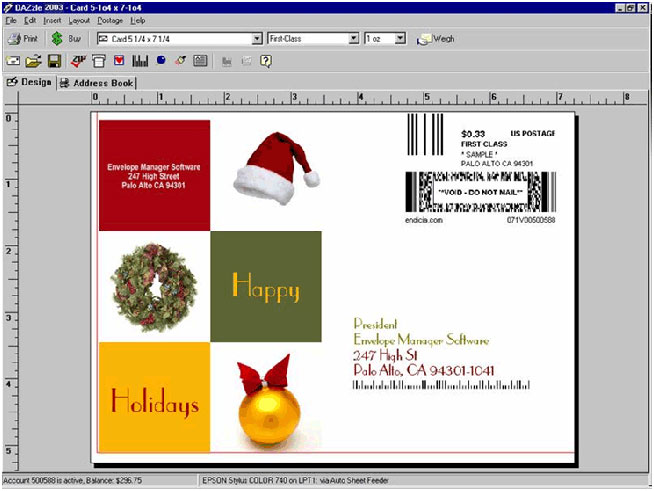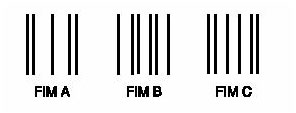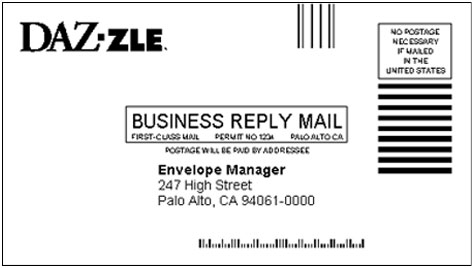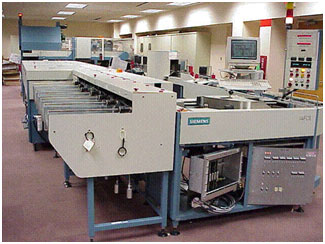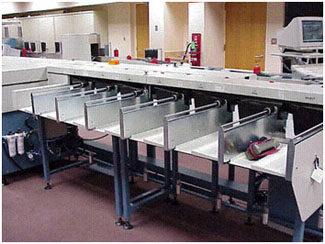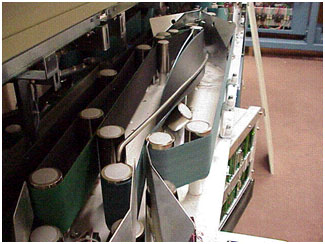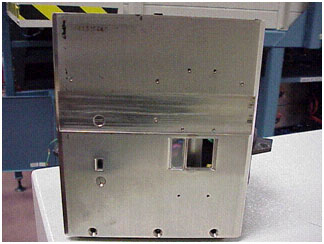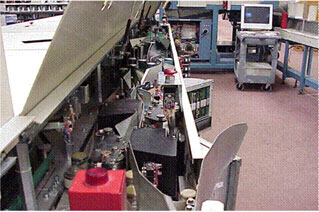Understanding FIM (Facing Identification Marks) on Envelopes
Overview
The Facing Identification Mark (or FIM) is used by the USPS to assist in the processing of letter mail. This small pattern of vertical bars plays an important role in speeding your envelope mail through the USPS system.
You can see one type of FIM pattern on the envelope design in Figure 1 (in the upper right hand corner). This pattern is a FIM D. The other common patterns you will see are FIM C and FIM A. The significance of these different patterns will be explained in this tutorial.
Figure 1: A PC Postage Envelope Design with FIM
The FIM Is for Envelopes - Not Shipping Labels
The FIM should only be applied to letter and postcard mail. The USPS equipment that processes flats and packages does not look for or use a FIM.
What Does the FIM Tells USPS Mail Processing Equipment?
The FIM tells a key USPS processing machine two things about the envelope. First, it alerts the machine as to what type of postage is (or should be) affixed to the piece. Second, it tells the machine if the mail piece already has a Intelligent Mail barcode representation of the delivery ZIP+4. You can see the Intelligent Mail barcode just below the address in Figure 1. Endicia software validates every U.S. address so we can confirm that the address is recognized by the USPS and print the Intelligent Mail barcode. You will see what a tremendous processing advantage this gives your envelopes.
The Common FIM Marks (A, B, & C)
The FIM A is used to designate an envelope which has a Intelligent Mail barcode and should contain a conventional stamp or a red postage meter ink mark. Conventional stamps contain an invisible phosphorescent ink and red postage meter ink contains a red fluorescent trace. Both materials - when excited with a short wave light source - emit a green or red signal which can be detected by a USPS machine called a Facer Canceller. The pre-addressed envelope you receive from your water company or credit card company typically will have a FIM A. This type of envelope is called a courtesy reply envelope - they have provided a preaddressed envelope as a courtesy to you. You are expected to place your payment in that envelope, affix a stamp or postage meter mark, and drop it in the mailbox. The billing entity wins big time on this because their pre-addressed and POSTNET encoded envelope gets to them quickly so they get your money that much sooner!
A FIM C is used for Business Reply mail as depicted in the figure below. This tells the USPS facer canceller the mail piece contains a Intelligent Mail barcode but also indicates that there will be no fluorescent ink to detect. The postage is paid by the recipient of the mail, using a permit billing system. They are only billed for the post cards sent back to them. You can see dozens of Business Reply postcards in any magazine you pick up.
A FIM B is used for Business Reply mail which doesn’t have an Intelligent Mail barcode. You will seldom see this because the USPS charges much more to the permit holder to process non-Intelligent Mail encoded reply mail. Plus, it’s easy to obtain a proper ZIP+4 for the reply address and use that to print thousands of pieces for distribution. (Our DAZzle software is used to design compliant artwork for Business Reply - it’s used by USPS Mail Piece Design Analysts nationwide as well a many commercial customers.)
Figure 2: A Business Reply Postcard with FIM C.
Figure 1 illustrates a FIM D which is used by PC-based postage systems. These systems use conventional Windows or Macintosh computer printers to create the mailpiece and postage indicium. The FIM D says that this mail is Intelligent Mail encoded and that the postage is there - but will not show a fluorescent trace.
What about Envelopes That Don't Carry a FIM?
Lots of envelopes enter the mail stream as hand written or computer generated and don’t have any FIM. In the absence of a FIM, the USPS Facer Canceller assumes that there is no Intelligent Mail encoding of the ZIP+4, that there is no ZIP+4 whatsoever, and that there should be a stamp or red meter mark on the mailpiece. As you will see in a minute, this determination consigns these envelopes into subsequent processing steps which FIM-encoded mail skip altogether.
Understanding the Facer-Canceller
You mail encounters the facer canceller the same evening that your mail is placed in a collection box, dropped at the Post Office, or given to your mail carrier. It’s done in an origin Sectional Center Facility (SCF) in the general areas of where you dropped your mail. There are several hundred SCF’s around United States. These are big, square-block-sized mail processing plants where the mail from surrounding areas is brought to every evening.
Figure 3 is a photo of one end of the facer-canceller. Figure 4 is a close-up of the discharge bins. A typical mail processing plant might have 5 or 10 of these units running at full speed between 6 PM and 1 AM.
If you look at the very right hand most bin of Figure 4, you will see that bin is labeled with a sticker saying REJECT. To ensure your mail speeds along to its destination, you want to stay out of this bin!
There are other bins that are not reject bins, but as we will see, some of those bins earmark your envelope for additional and potentially time-consuming processing steps.
Finally, some of the bins are dedicated to FIM A, FIM C and FIM D mail. It’s a good thing to have your envelope come out in one of those bins. If they do, they are expeditiously moved to the next sortation steps and are sent out to the destination city (by truck or aircraft) around mid-night.
Figure 3. The Advanced Facer-Canceller Machine
Figure 4: The Discharge Bins of the Facer-Canceller
What Functions Are Performed by the Facer-Canceller?
These complex machines do quite a number of things. More or less in order of operations,
- They orient the letters so that they are all facing the same way and are right-side up (see Figure 5).
- They read the FIM - if one is on the envelope (see Figure 6)
- Depending upon the FIM, they look for the florescent trace associated with a conventional stamp or postage meter ink./li>
- They photograph the address block of the envelope (Figure 7). This is for a process called Remote Video Encoding (RVE)
- They spray an orange-pink barcode on the back side of the envelope (used for RVE)
- If a conventional stamp is detected, they print a cancellation mark over that stamp (so it can’t be reused).
- Finally, they separate the mail in discharge bins according to FIM code, lack of FIM code, or reject (meaning that there evidently is no postage on this piece) (see Figure 4)
The amazing thing about this is that they process the letters so quickly that they seem like a blur when you look at the machine!
Figure 5. The belts which reorient envelopes so they are all facing the same way.
Figure 6: The Subcomponent which Scans the FIM and Detects the Phosphorescence or Fluorescence.
Figure 7: The high speed address camera and RVE barcode sprayer.
The Fate of the Hand Written Envelope with Conventional Stamp
This type of mailpiece will not have a FIM so the facer-canceller will look for the phosphorescent trace of the stamp (or the fluorescence of the meter mark) as evidence of postage payment. Note that this process can’t detect the value of the stamp or meter mark - just if one is there!
Assuming fluorescence or phosphorescence is detected, the envelope will be discharged into a non-reject bin. But the mail in that bin will then go into a holding area. Meanwhile, the photograph of that envelope will be telecommunicated to a remote video encoding facility which is staffed by dozens of operators looking at the envelope images on computer screens. The operators input the key address information in a shorthand format so that the correct ZIP+4 for this address can be computed. This information is sent back to the SCF and, hours later, these letters in the holding pen are run through another machine which literally sprays the correct Intelligent Mail barcode on the lower right corner of the envelope. The machine knows what Intelligent Mail barcode to spray on a given envelope by reading the pink RVE barcode that was assigned by the facer-canceller.
The Fate of Your Mortgage Payment Envelope with a FIM A and Conventional Stamp
This envelope will do very well compared to the hand written one. The facer-canceller will see the FIM A and know that the POSTNET barcode is already assigned to this envelope. It will therefore not transmit the picture of this envelope to the RVE facility. Provided there is a stamp or meter mark on the envelope, it will end up in the FIM A bin. Envelopes in the FIM A bin immediately go to the Intelligent Mail barcode sorters which segregate the mail by destination city or geographic region. This sorted mail is then loaded on the trucks and aircraft immediately.
The Fate of Your Endicia PC Postage Envelope with FIM D
This envelope will be handled in much the same way as the FIM A example. The FIM D will alert the facer-canceller that the envelope contains neither phosphorescence nor fluorescence, so this check will be skipped and the envelope will discharge in a FIM D or FIM A bin. It immediately goes to the barcode sorter and is loaded on to outbound transportation.
The Fate of a Computer Generated or Typed Envelope with No FIM
The facer canceller will look for a fluorescent stamp or meter ink. The RVE cameras can generally tell if the envelope is handwritten or printed with computer or typewriter. If it makes the determination that it is printed, it will discharge the envelope into yet another bin. Mail in this bin is then taken to a machine called the Optical Character Reader or OCR. This machine uses a computer to scan the address and convert the scan to characters. It then looks up the proper ZIP+4 for this address (if possible) and then sprays the Intelligent Mail barcode on the lower right corner of the envelope.
This machine is quite fast, but it does add another step to the mail processing before they envelopes can go to the final barcode sorting machine and out the door.
Why Does the USPS Go to Such Trouble to Put an Intelligent Mail Barcode on All Envelopes?
You can see that some of the processes the USPS goes through to put a barcode on each envelope are time-consuming and costly. The RVE process is the most extreme example of this. Why do they go to so much trouble to do this at the outbound SCF?
The Intelligent Mail barcode is scanned multiple times between the outbound SCF and final destination. It may be sorted 6-10 times as it makes it way from origin to destination. Each sortation is done to a finer and finer level.
For instance, let’s say an envelope is being sent from San Francisco to Long Island, NY. The origin SCF is the San Francisco processing plant. The envelope will run perhaps through two or three barcode sorters in that facility so that it is co-mingled with other letters going by air to the NYC area.
The next day, the envelope will very likely arrive at the NYC Airport Mail Facility (AMF) where other barcode sorters will sort the envelope to a group being transported by truck to an SCF in Long Island. The mail will get to the SCF in Long Island and be sorted once again so that the envelope is directed to the appropriate Post Office serving the destination address. A final barcode sorter at the destination Post Office will sort the mail in the order that the mail carrier walks or drive his/her route.
So the Intelligent Mail barcode is used extensive downstream in the mail delivery process. That’s why the USPS goes to such trouble to put that barcode on every letter and postcard at the origin SCF.
Are You Telling Me That USPS Automation Equipment Can't Tell If Sufficient Postage Is Affixed?
If you’ve followed all of the above, you realize that this is true. The only automated check for postage on envelopes is the facer canceller which determines if the mail piece contains a stamp with a phosphorescent tag. All stamps over 10 cents in value contain this tag, but the facer canceller cannot distinguish the actual postage value. Stamps with a value of 10 cents or less do not contain the tag and are automatically rejected for manual review.
So, insufficient postage - if caught at all - is caught by the delivering carrier.
The newest generation of facer cancellers can now detect/read the 2D barcode in PC postage pieces and actually tell how much postage has been applied. But these machines don’t capture weight so they really can’t verify if the postage is correct. But it’s definitely a step forward for the USPS auditing capabilities.
Further Implications of the FIM
Now you are in a position to understand some subtleties about envelope mail - particularly as it applies to PC Postage letters. For instance, folks often ask if they can use Endicia to create an IBI postage barcode to use on the courtesy reply envelope for their credit card or water bill payment. Let’s say that we simply printed out the postage indicium (what’s in the upper right corner of Figure 1) on plain paper, cut out the 2D barcode, and taped it to the courtesy reply envelope.
If the FIM A of the original courtesy reply envelope was still visible, the facer canceller would assume that some sort of fluorescence or phosphoresence will be present on the envelope. But your Endicia PC postage indicium is created with plain black ink on your printer. Even if you used a red ink for this indicium, it wouldn’t have the fluorescent trace that meter ink has. So, your envelope would end up in the REJECT bin of the facer-canceller.
USPS personnel go through all the rejects one by one. They would find your envelope and see that it indeed had a form of postage and probably would let it go through to the next processing steps. But your mail would be delayed because of this manual intervention.
Now how could you make this work? If you printed your PC postage with the FIM D, and cut out both the postage indicium and the FIM D, and pasted that on the top right corner of your courtesy reply envelope, the facer-canceller would have no problems with your mailpiece.
Alternately, if the envelope is not a window envelope, you could just create an envelope from scratch using Endicia and mail your payment in that way. You would simply discard the courtesy reply envelope provided by the billing agency.
There is a way to deal with this situation. You can print single stamps at home or in your office either using a special Endicia sheet stock (for ink jets or laser jets), or a special roll stock that will fit in many DYMO thermal printer models. You can find these products at our online store.
In both cases, the paper has - guess what - a fluorescent red or orange strip on it! That means it will be treated as a conventional stamp so an envelope with no FIM or a FIM A will go through without problem. The downside of this approach is that you need to buy (and always have on hand) the special fluorescent paper which adds to your postage cost. If you mail mostly 45 cent envelopes, it will be cheaper just to order a roll of conventional stamps from the USPS on their web site or through your carrier. But if you have the need for
A Fun Night Out!
Talk to your Post Master and find out when your nearest SCF is having tours. Typically, they provide free tours at least once a month. I guarantee you that you’ll be astonished at the scale of the operations, and come away with a much greater appreciation of the USPS. Bring a date - it’s an evening they won’t forget!
